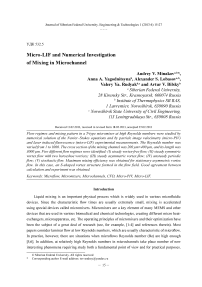Micro-LIF and numerical investigation of mixing in microchannel
Автор: Minakov Andrey V., Yagodnitsyna Anna A., Lobasov Alexander S., Rudyak Valery Ya., Bilsky Artur V.
Журнал: Журнал Сибирского федерального университета. Серия: Техника и технологии @technologies-sfu
Статья в выпуске: 1 т.6, 2013 года.
Бесплатный доступ
Flow regimes and mixing pattern in a T-type micromixer at high Reynolds numbers were studied by numerical solution of the Navier–Stokes equations and by particle image velocimetry (micro-PIV) and laser induced fluorescence (micro-LIF) experimental measurements. The Reynolds number was varied from 1 to 1000. The cross section of the mixing channel was 200 μm×400 μm, and its length was 3000 μm. Five different flow regimes were identified: (I) steady vortex-free flow; (II) steady symmetric vortex flow with two horseshoe vortices; (III) steady asymmetric vortex flow; (IV) unsteady periodic flow; (V) stochastic flow. Maximum mixing efficiency was obtained for stationary asymmetric vortex flow. In this case, an S-shaped vortex structure formed in the flow field. Good agreement between calculation and experiment was obtained.
Microflow, micromixers, microchannels, cfd, micro-piv, micro-lif
Короткий адрес: https://sciup.org/146114714
IDR: 146114714


